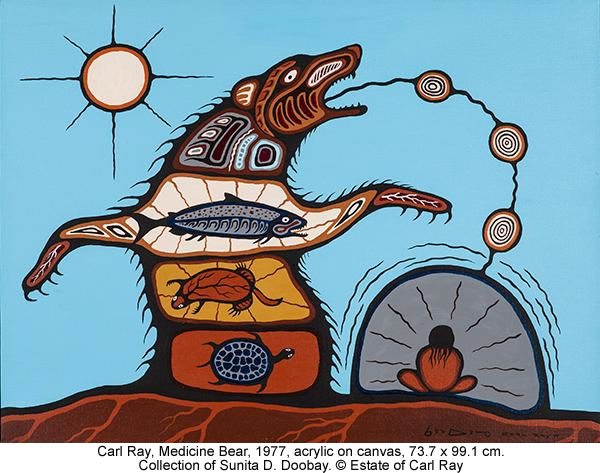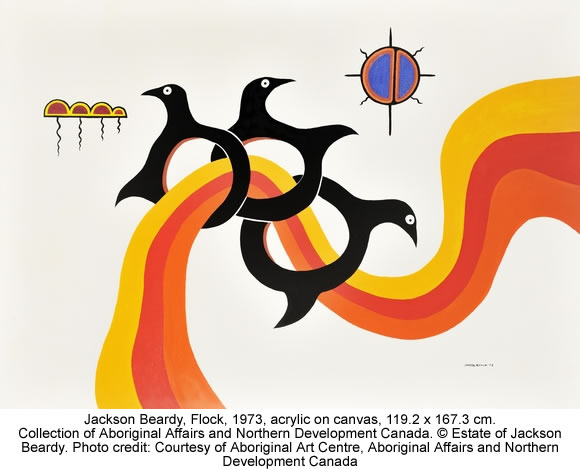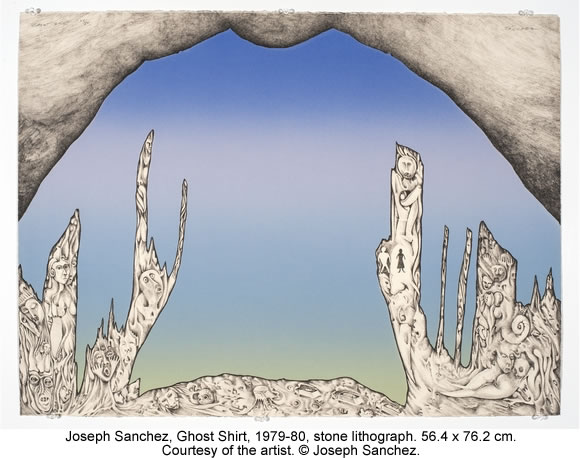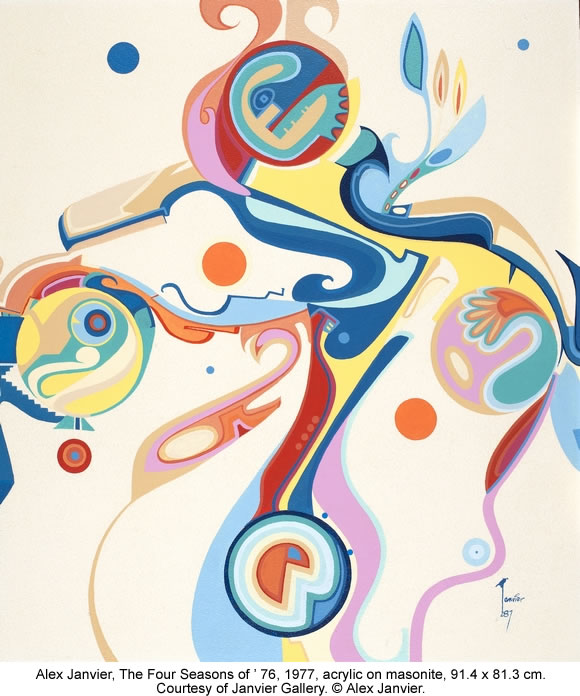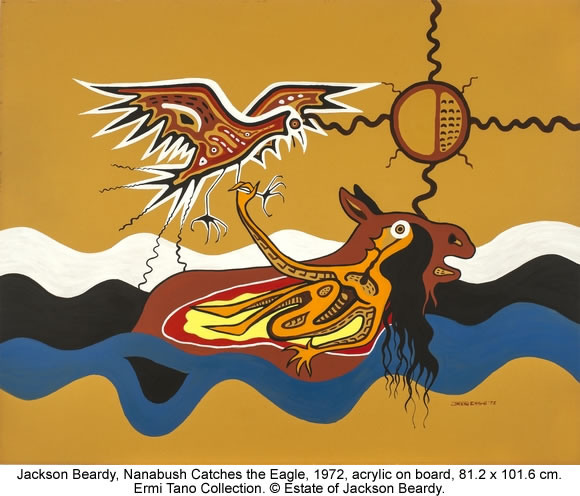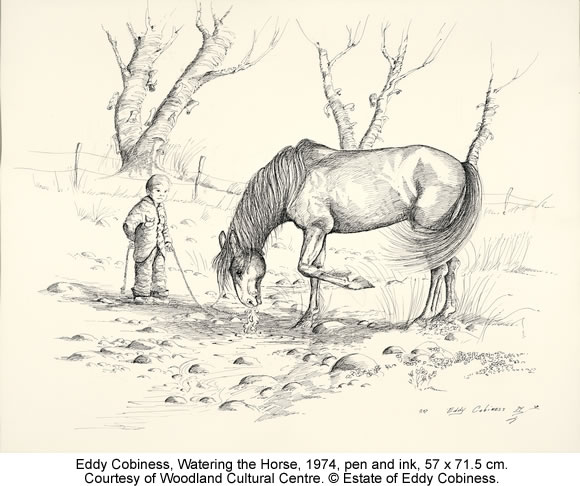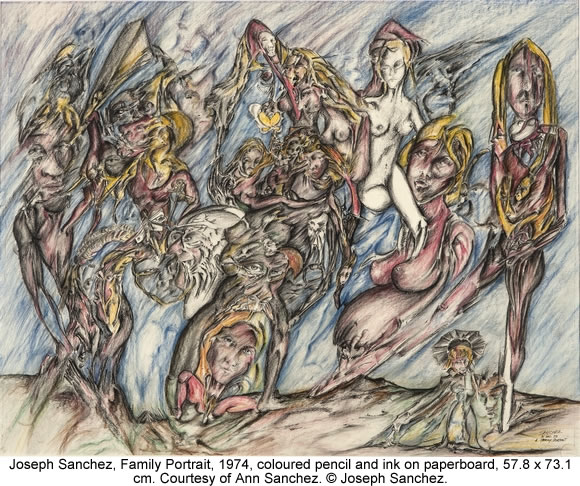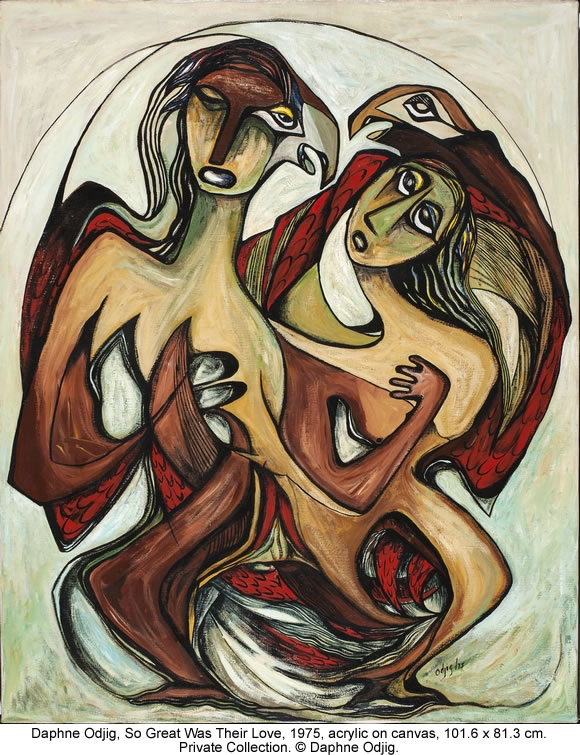 |
Canku Ota
|
 |
|
(Many Paths)
|
||
|
An Online Newsletter
Celebrating Native America
|
||
|
February 2014 - Volume
12 Number 2
|
||
|
|
||
|
Art, Inc.: How 7
Native Painters Broke Through by Going Corporate
|
||
|
by Alex Jacobs - Indian
Country Today Media Network
|
||
|
credits: unless otherwise
noted: all photos by Don Hall)
|
|
An exhibit of a critically and politically important group of First Nation Artists, "7: Professional Native Indian Artists Inc.," closes this Sunday, January 12 at the MacKenzie Art Gallery in Regina Saskatchewan. It goes on tour with large gaps of time between venues, next is Winnipeg Art Gallery from May 9 to August 31, then Kelowna Art Gallery in Kelowna, BC from October 11 to January 4, 2015, and last is the McMichael Canadian Art Collection in Kleinburg, Ontario near Toronto from October 24, 2015 to January 17, 2016. It is possible that with more publicity this important exhibit will be accepted at more venues to be seen by more people. Norval Morrisseau (1932-2007), Carl Ray (1942-1978), Jackson Beardy (1944-1984), Eddy Cobiness (1933-1996), Daphne Odjig (b. 1919), Alex Janvier (b. 1935), and Joseph Sanchez (b. 1948), comprise the Group of 7, founded in the early 1970's and officially incorporated in 1974. This exhibit at the MacKenzie Art Gallery presents 120 pieces but the future shows will exhibit only 85 pieces. Joseph Sanchez, who resides in Santa Fe, told me issues with the catalog probably kept publicity down, but the catalog will finally be available on February 1, 2014. Every piece of art will have its own page in the catalog, so one can only hope the exhibit finally gets its due.
Alex Janvier and Joseph Sanchez remain the last artists able to travel and were there in Regina at the opening on September 20, with curator Michelle LaVallee and Jackson Beardy III, who performed hoop dance and drum. The group that would become Professional Native Indian Artists, Inc. (PNIAI) felt the need to "organize and incorporate, demanding recognition as professional, contemporary artists, to challenge old constructs and to stimulate a new way of thinking about contemporary Aboriginal people, their lives and culture." This happened a generation before the term First Nations was even coined. Private and public collections donated work and a number of recently uncovered masterworks that were not publically accessible have added to the mystique and significance of the exhibit. These selections "serve to challenge the myth that PNIAI members participated in a unified ‘Woodland Style', as well as to substantiate the avant-gardism of the Group." The Group of 7 organized "to fight for their inclusion within the Canadian mainstream and the contemporary art canon." All this occurred in the era of Canada's controversial Indian Policy (The White Paper) of 1969, and PINAI's work "addressed colonialization, exclusion, marginalization and denial of historical and contemporary realities."
Joseph Sanchez is the only non-Canadian artist in the Group and met Daphne Odjig in Manitoba in 1971. He served in the U.S. Marine Corps and deserted to Canada because he refused to train as a riot police member. He was repatriated under the Gerald Ford Presidential Amnesty in 1975. He has always been politically active -- with organizations such as the National Association of Artist Organizations, MARS (Movimiento Artistico del Rio Salada), ARIZTLAN, and ARTS -- designing exhibitions, curatorial services, administering collections and arts consultation. From 2002 to 2010 Sanchez served as a Director/Curator at MoCNA (the Institute of American Indian Arts Museum), in 2011 he became exhibition curator of Native American Art at Dartmouth College. Sanchez says the Group of 7 was important because they gave back to the people, they broke down barriers, they bought art from First Nation artists, created economic opportunities in the cities and reservations, all the current funding possibilities for artists, education and curators come from their struggle to be accepted as legitimate and professional Native Artists. He wrote in his essay for the show, "we were Indigenous artists who intended to change a stagnant and conformity-based art world with original artistic expressions…We acknowledged a human relationship to and responsibility for the diverse life on Earth… Norval Morrisseau became world renowned, his influence extends globally and he remains one of Canada's greatest artists. Morrisseau and the Group of 7 were able to depict Canada's rich indigenous history with the power to defy centuries of Eurocentric aesthetic expression…he created a trail wide enough for all of Canada to follow." Canadian Art Magazine called the Group of 7 exhibit Ten Art Shows to See This Fall.
At first they were refused funding and exhibition space, as well as the rejection of Native Arts as fine art and being of any importance. 50 artists were invited and only 7 came together, many agents told their artists not to join. There was a Canadian Group of 7, all landscape painters like the Hudson River School in NY. The press derided them as "The Indian Group of 7" but the PNIAI kept the name and then legally incorporated to show their resolve. They finally broke through at Dominion Gallery in Montreal in the early 70's, the gallery was showing Rodin, and Alex Janvier asked owner Max Stern, since they were known for bringing art from all over the world to Canada, why can't they showcase this new art from inside Canada. That finally did it. And now, says Sanchez, look at all the awards, the honorary doctorates, the one-man shows, all the work, all the art, all the people touched and the creation of the Woodland Art Movement. They will even, in a sense, "take over" the Canadian Group of 7's own museum when the show travels to the McMichael Canadian Art Collection in Kleinburg, Ontario, just outside Toronto. Joseph Sanchez paints almost every day at his studio on Lena Street behind the sprawling Second Street Studios in Santa Fe. After reading his extensive bio, I told him I should've treated him better all these years. Joseph laughed and said, "that just means I'm old." He has now gotten exhibition offers stemming from this show, he has all the archives and papers from all the old exhibits and organizations. While the other 6 members have been widely collected, Sanchez has not had many official Canadian purchases because he was the only American. He painted side by side with Daphne Odjig because he had no studio and few supplies. She is 95 now and is a Native and Canadian icon, she supported so many people back in the day. Odjig says of the Group of 7, "We acknowledged and supported each other as artists when the world of fine art refused us entry."
As it turns out, it's a very busy week across Turtle Island. On Monday, January 13, the Woodland Cultural Centre (Oshweken, Six Nations) presents a Fashion Show to open their exhibit, FashioNative that runs from January 15 to April 18. First Nations designers Angela DeMontigny, Sage Paul, Chessa Syrette, and Tracy Toulouse will showcase their wearable art. In New York City, AMERINDA Inc. presents the film, "Miss Lead" written by Mary Kathryn Nagle, directed by Madeline Saget, it's about an 18 year old girl who becomes ill and has to move back to the Tri-State Mining District, where she meets a Quapaw Indian who teaches her that her illness and identity are rooted in the soil and the land. NYC based Native actors Dylan Carusona, Dawn Jamieson and Tanis Parenteau and others have roles. Miss Lead is showing at the 59E59 Theaters, 59 East 59th St, NYC, from Thursday, January 16 at 7:15pm until Sunday, January 26 at 3:15pm.
These are not happening in Santa Fe, but because it is Santa Fe, our friends tell us where the happenings are. There is another huge, influential exhibit called Beat Nation that is crossing Canada. Group of 7 is mostly paintings, as you would expect from 1970's -- while Beat Nation does not have the usual complement of Art as Objects, it is hip-hop influenced, mainly installation and multi-media. The Beat Nation catalog is a big reason the show has been become popular and influential, perhaps the Group of 7 catalog will push this exhibit into prominence. And as a matter of fact, Beat Nation will be presented at MacKenzie Art Gallery after Group of 7 ends.
And what is happening in Santa Fe is the Institute of American Indian Arts MFA Program in Creative Writing, is holding its Writers Festival Reading Series, as Sherman Alexie, Linda Hogan, Sherwin Bitsui, Natalie Diaz, Santee Frazier, Chip Livingston, Ken White, Joan Kane, Gabrielle Calvocoressi, Ramona Ausubel, Chris Merrill, Melissa Febos and department head Jon Davis, have been reading all week. IAIA offers a remarkable low residency MFA in Creative Writing, meaning you commute from your home computer or laptop and work with these poets and writers as tutors, and with other authors, and after so many months, festivals, and fees, you earn an MFA in Creative Writing. This Festival started with award-winning writer Linda Hogan presenting her new collection of poems "The Remedies" and ends tonight with Sherman Alexie packing the house again. Alex Jacobs, 1/10/14 Alex Jacobs, Mohawk, is a visual artist and poet living in Santa Fe.
7:
Professional Native Indian Artists Inc. - MacKenzie Art Gallery Native
American Art at Dartmouth - Highlights from the Hood Museum of Art Woodland
Cultural Centre Beat
Nation – Hip Hop as Indigenous Culture The
Institute of American Indian Arts |
|
|
||
|
|
||
| Canku Ota is a free Newsletter celebrating Native America, its traditions and accomplishments . We do not provide subscriber or visitor names to anyone. Some articles presented in Canku Ota may contain copyright material. We have received appropriate permissions for republishing any articles. Material appearing here is distributed without profit or monetary gain to those who have expressed an interest. This is in accordance with Title 17 U.S.C. Section 107. | ||
|
Canku Ota is a copyright ©
2000 - 2014 of Vicki Williams Barry and Paul Barry.
|
||
 |
 |
|
|
The "Canku
Ota - A Newsletter Celebrating Native America" web site and
its design is the
|
||
|
Copyright ©
1999 - 2014 of Paul C. Barry.
|
||
|
All Rights Reserved.
|
||
